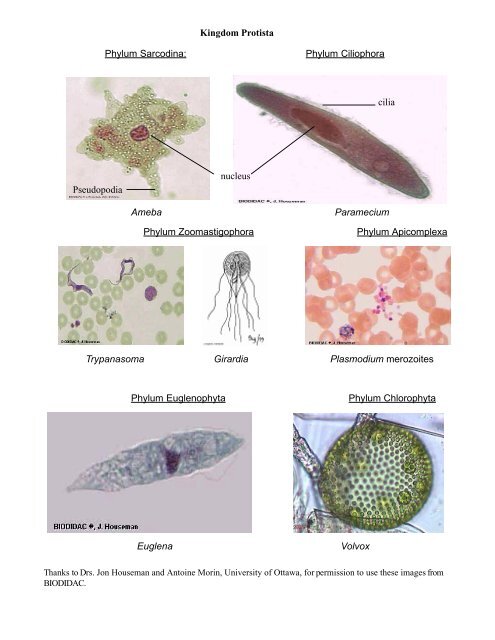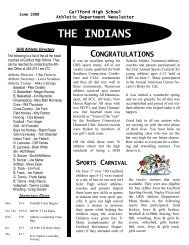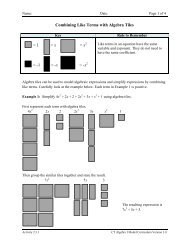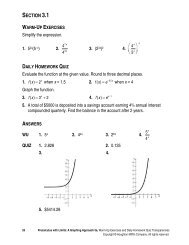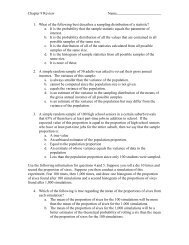Phylum Sarcodina: Phylum Ciliophora Phylum Zoomastigophora ...
Phylum Sarcodina: Phylum Ciliophora Phylum Zoomastigophora ...
Phylum Sarcodina: Phylum Ciliophora Phylum Zoomastigophora ...
You also want an ePaper? Increase the reach of your titles
YUMPU automatically turns print PDFs into web optimized ePapers that Google loves.
Kingdom Protista<br />
<strong>Phylum</strong> <strong>Sarcodina</strong>:<br />
<strong>Phylum</strong> <strong>Ciliophora</strong><br />
cilia<br />
Pseudopodia<br />
nucleus<br />
Ameba<br />
Paramecium<br />
<strong>Phylum</strong> <strong>Zoomastigophora</strong> <strong>Phylum</strong> Apicomplexa<br />
Trypanasoma Girardia Plasmodium merozoites<br />
<strong>Phylum</strong> Euglenophyta <strong>Phylum</strong> Chlorophyta<br />
Euglena<br />
Volvox<br />
Thanks to Drs. Jon Houseman and Antoine Morin, University of Ottawa, for permission to use these images from<br />
BIODIDAC.
Kingdom Animalia, Subkingdom Parazoa<br />
<strong>Phylum</strong> Porifra<br />
sponge spicules<br />
Sponge sponge gemmules<br />
Subkingdom Eumetazoa<br />
<strong>Phylum</strong> Cnidaria<br />
Class Hydrazoa<br />
endoderm<br />
ectoderm<br />
mesoglea<br />
x-section of Hydra Hydra Portuguese man-o-war
<strong>Phylum</strong> Cnidaria<br />
Class Hydrazoa (continued)<br />
reproductive colony<br />
Obelia medusa<br />
feeding colony<br />
Obelia, an example of a colonial hydroid polyp<br />
endoderm<br />
tentacle<br />
immature medusa bud<br />
ectoderm<br />
gastrovascular<br />
cavity<br />
Obelia feeding colony<br />
Obelia reproductive colony - demonstrates asexual budding
<strong>Phylum</strong> Cnidaria, Class Scyphozoa<br />
Aurelia, a common jellyfish (medusa stage)<br />
Hydroid Aurelia<br />
<strong>Phylum</strong> Cnidaria, Class Anthozoa<br />
Coral skeleton<br />
Live Coral<br />
Sea Anemone
<strong>Phylum</strong> Platyhelminthes, Class Turbellaria<br />
Planaria<br />
Planaria<br />
<strong>Phylum</strong> Platyhelminthes, Class Trematoda<br />
Sheep liver fluke<br />
<strong>Phylum</strong> Platyhelminthes, Class Cestoda<br />
Schistosoma mansoni, a blood fluke<br />
tapeworm proglottid<br />
tapeworm scolex<br />
tapeworm cysticercus
<strong>Phylum</strong> Rotifera<br />
<strong>Phylum</strong> Nematoda<br />
Rotifer Trichina encysted in muscle heartworm<br />
<strong>Phylum</strong> Annelida<br />
Earthworm<br />
Sandworm
<strong>Phylum</strong> Annelida, continued<br />
leech<br />
<strong>Phylum</strong> Mollusca<br />
round clam<br />
scallop
<strong>Phylum</strong> Mollusca, continued<br />
squid<br />
snail (shell)<br />
conch
<strong>Phylum</strong> Arthropoda, Class Insecta<br />
Order Lepidoptera<br />
Swallowtail<br />
Monarch<br />
Order Orthoptera<br />
Order Homoptera<br />
17 year cicada<br />
Order Odonata<br />
praying mantis<br />
dragonfly
<strong>Phylum</strong> Arthropoda, Class Crustacea<br />
Crayfish<br />
Blue Crab<br />
Class Arachnida<br />
brown recluse spider black widow spider
<strong>Phylum</strong> Arthropoda, Class Arachnida (continued)<br />
Dog tick<br />
Deer Tick, all 4 stages<br />
This one can carry the Lime Disease rickettsiae<br />
Class Myriapoda<br />
centipede<br />
millipede
<strong>Phylum</strong> Echinodermata<br />
starfish<br />
sea urchin<br />
<strong>Phylum</strong> Chordata, Subphylum Vertebrata<br />
Class Agnatha<br />
Lamprey, feeding on fish<br />
hagfish
Class Chondrichthyes Class Osteichthyes<br />
dorsal fin<br />
caudal fin<br />
ray<br />
Class Amphibia<br />
anal fin pectoral fin<br />
pelvic fin<br />
Class Reptilia<br />
mudpuppy<br />
tortoise<br />
Class Aves<br />
Class Mammalia, Order Carnivora<br />
Roadrunner


